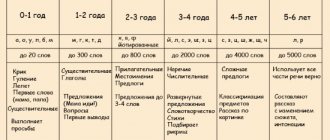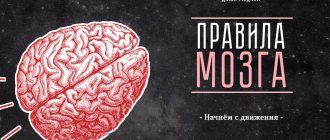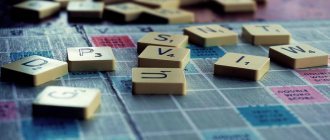Mnemonics (mnemonics techniques) are special methods of memorizing certain types of information, based on the peculiarities of human psychology, as well as on the four rules of memorization that were given in previous lessons. Knowledge and use of special mnemonics will allow you to better remember digital information, specific texts and terms, names, faces and surnames, foreign words, expressions and much more.
This lesson will cover the basics of mnemonics, and also describe the basic techniques and methods for memorizing various types of information.
How does mnemonics work?
Methods of memorization using associations are mnemonics.
To make it clearer, let’s remember right now the word Guamocolatokint - the name of an eagle owl from A. Volkov’s fairy tales. It’s difficult to read, let alone remember. But not for mnemonics! Imagine a large jar of red gouache that tips over and spills onto a stack of waste paper. We crumple up the newspapers covered in paint and try to stuff them into a huge kinder egg, but there is so much waste paper that the egg just won’t close.
What was it? The very associations that will help us remember the name of the eagle owl. Guamocolatokint: gouache - “gua”, waste paper - “mocolato”, kinder - “kint”. Repeat this word 2-3 times, imagining this “cartoon”, and it will be imprinted in your memory for a long time. Congratulations, you have just become a mnemonics practitioner.
The same “figurative work” can be done to quickly and firmly memorize complex terms, foreign words and any information in general ⇓
To memorize, you can use not only imagination, but sound and tactile perception. But it is the visual option that gives the greatest effect - our brain processes pictures much faster than linear text or abstract concepts. We will talk about this type of mnemonics today.
Basic mnemonic devices:
The applied arsenal of modern mnemonics consists of a large set of unified memorization techniques. Among the main mnemonic techniques and methods are the following:
- Letter code. Formation of semantic phrases from the initial (or purposefully assigned) letters of memorized information.
- Associations. Finding vivid, unusual associations that connect to memorized information.
- Rhymes. Creating rhyming pairs of words or even short poems containing memorized material.
- Consonance. Memorizing terms or foreign words using consonant already known words or phrases.
- Roman room method. Assigning memorized objects to specific locations in a room you know well.
In this lesson, for ease of learning, all mnemonics will be divided into groups depending on the type of information that these mnemonics help to remember.
What is good about mnemonics?
Suitable for any purpose.
You can memorize foreign vocabulary and geographical maps, chess games and historical dates, classifications in biology and formulas from trigonometry. Dictionary words, definitions, poems and entire texts verbatim. There are no restrictions in either the quality or quantity of information.
Provides “phenomenal memory.”
Mnemonics does not require any ability from you - it is a skill that can be easily practiced at any age.
Trains the brain.
Memorizing through images develops imagination and improves attention.
Works immediately.
All techniques are simple and clear and give instant results. You will see this for yourself in a couple of minutes.
We all use mnemonics since childhood.
Remember the saying about every hunter who wants to know where the pheasant sits, with which we forever remembered the order of rainbow colors? Or a song that helped me learn the sequence of notes: “DO - sparrow’s nest, RE - trees in the yard...”. And how we taught cases: “Ivan gave birth to a girl, ordered her to drag a diaper,” or the spelling of adverbs: “I can’t bear to get married.” And what about Pythagorean pants and the bisector rat?
All these are mnemonic techniques, the so-called mnemonics, acrostics and mnemonic phrases. They are not the most effective, since they are applicable to narrow tasks, but with their help we reproduce the necessary information even after decades. This is the whole point of mnemonics - it’s easy to remember, but difficult to forget.
For different ages
For preschoolers
Mnemonics are actively used by educators and speech therapists for the development of speech in kindergarten with the help of mnemonic squares and mnemonic tracks. First, the child must name what is shown in the picture (visual associations are triggered and at the same time the vocabulary is replenished). Then he composes sentences and entire stories using several illustrations at once (the grammatical speech is enriched). The most complex one in this chain is the mnemonic table, which helps a preschooler learn a full-fledged poem.
For school age children
The education system is the most fertile field for the use of mnemonics. In order to assimilate huge amounts of information on various subjects, consonance and rhyme will be useful for developing the memory of schoolchildren, examples of which are in the tables above. Starting from the age of 10, experts advise parents and teachers to gradually teach children the methods of Cicero and Aivazovsky. You can also use other exercises: creating your own language, developing cuneiform, password recall and others.
For adults
For the development of memory for adults, it is already too late to learn poetry in order to remember the sequence of cases in the Russian language. They need more complex techniques, working with numbers, visual and auditory detail of what is happening. The pinnacle of perfection will be mastering the Giordano system or at least trying to take part in the correspondence round of the mnemonics competition.
A Brief History of Mnemonics
If our memory were so perfect that we could remember information in an unlimited amount, there would be no need to invent writing and invent digital media. Knowledge would still be passed on by word of mouth.
And this is exactly how they were passed on for a long time, developing the art of mnemonics among the thinkers and poets of the past. If it were not for memorization techniques, much scientific knowledge, works of folk art, and such masterpieces of world art as “The Iliad” and “Odyssey” would have been lost “along the way.”
It is believed that the word with the root “mnemo” was introduced by Pythagoras in VI BC. e., combining its meaning with the goddess of memory Mnemosyne. This is how the term “mnemonics” appeared - the art of memorization, and later - “mnemonics”. Ancient Greece also used mnemonics as an intellectual sport - demonstrating the art of memorizing large amounts of information (often meaningless) in front of an audience.
The ability to use your memory was considered a rule of good manners. It is difficult to imagine Cicero reading a brilliant speech “from a piece of paper”. Aristotle and Pythagoras, Julius Caesar and Nikola Tesla, Giordano Bruno and Napoleon used mnemonics. Many not only knew how to use it masterfully, but also set out memorization techniques in treatises and books.
The development of technologies for replication and transfer of knowledge was largely due to the need of humanity to record it on a more reliable medium than a “handful of neurons.” This is how mass education became possible.
But paradoxically, it is now, in the age of the Internet and mobile devices, that the issue of using memory has returned to us with even greater relevance. To learn how to manage the process of memorization in an avalanche-like flow of information, the good old mnemonics, which has proven itself perfectly for 2.5 thousand years, comes to our aid again.
The best books on mnemonics
Arthur Dumchev “Remember everything. A practical guide to memory development"
This book contains examples of exercises in different ways to develop quick memorization. Arthur memorized the number Pi up to 22529 digits.
Using the author's advice, readers learn to find solutions to complex problems in their minds and operate with long digital chains. Intelligence moves to a new level.
Prices for Dumchev Arthur Remember everything. A practical guide to memory development
Find out more about the book
Roger Sipe, Brain Development. How to read faster, remember better and achieve greater goals"
The collection of the famous author, teacher of strategies and tactics of self-development, presents a number of innovations and methods for better memorization and quick reading.
Roger Sipe Prices Brain Development. How to Read Faster, Remember Better, and Achieve Bigger Goals
Find out more about the book
Joshua Foer Einstein Walks on the Moon. The Science and Art of Memory"
The book tells the story of the period of time that the author spent studying his own memory abilities. For a whole year he revealed internal potentials, hidden mechanisms, protective nuances and trained.
Prices for Joshua Foer Einstein Walks on the Moon. The Science and Art of Memory
Find out more about the book
Tony Buzan "Super Memory"
The author invites the reader to develop the ability to remember, preserve, and reproduce. Tony Buzan's instructions and advice lead to such results when the memory mechanism serves for a long time and without fail.
Prices for Tony Buzan Super Memory
Find out more about the book
Dominic O'Brien "How to develop Super Memory"
Any person, if desired, can remember vast amounts of information, in numbers, events, lists, and in the form of texts. If you don’t believe me, we recommend trying to work with your memory using the O’Brien method. The exercises will give a unique result in a few weeks.
Prices for Dominic O'Brien How to develop Super Memory
Find out more about the book
Denis Bukin “Development of memory using the methods of special services”
The work was released for those who have difficulty remembering information. Denis Bukin teaches how to improve the capabilities of the mind, become bolder in a team, more effective in a career, family, and maximize the potential of thinking.
Prices for Denis Bukin Development of memory using the methods of special services
Find out more about the book
Stanislav Matveev “Phenomenal memory. Methods of remembering information"
Scientists have proven that the ability to remember is trained even more successfully than the biceps. When you start to forget something, you need to train your brain. This gap in your biography can be easily corrected if you read the recommendations of the memory champion among Russians.
Prices for Stanislav Matveev Phenomenal memory. Methods for remembering information
Find out more about the book
Christine Loberg, Mike Beister "Quick Mind. How to forget what is unnecessary and remember what is necessary"
The path to great success is opened by the talent to remember well and process voluminous information faster than others. These talents can be developed, the author believes, by offering unusual ways and interesting exercises.
Prices for Kristin Loberg, Mike Beister Quick Mind. How to forget what is unnecessary and remember what is necessary
Find out more about the book
Neal Barnard, Brain Nutrition. An effective step-by-step technique for enhancing brain efficiency and strengthening memory"
Ten percent of elderly people over the age of seventy have Alzheimer's disease. Neal Barnard recommends healthy eating and exercise to stave off disordered thinking, dementia and memory loss.
Prices for Neal Barnard Brain Nutrition. An effective step-by-step technique for enhancing brain efficiency and strengthening memory
Find out more about the book
Angels Navarro “Memory does not fail. Tasks and puzzles for the development of intelligence and memory"
After getting acquainted with this work, you will learn about the work of the brain, how to maintain clarity of thinking until the last days of life. Angels Navarro suggests solving interesting puzzles, unusual tasks and synthesizing new connections between neurons in the cerebral cortex.
Prices for Angels Navarro Memory serves. Tasks and puzzles for the development of intelligence and memory
Find out more about the book
Harry Lorraine, Jerry Lucas “The Development of Memory. The classic guide to improving memory"
You can achieve real records in various areas of life when you read this simple guide. Potential memorization abilities, the ability to process large amounts of text, numbers and figures will be revealed.
Prices for Harry Lorraine, Jerry Lucas Memory Development. The classic guide to improving memory
Find out more about the book
Where is it useful to use mnemonics?
The same exercises can help in many different areas of life. Let's take a closer look at where to use mnemonics.
In study and work
Mnemonics opens up broad horizons for learning: be it retraining courses, second higher education or driving theory. After all, 90% of learning activities involve memorization.
At work, mnemonic skills help you perform well in public speaking, as well as organize any information you need to remember, such as keeping a task list in your head.
For learning foreign languages
Mnemonics allows you to learn from 100 to 500 foreign words in 1 day. Just 2-3 months of intensive classes - and you can form the vocabulary of a graduate of the linguistic faculty. You can start with 10 words, like in the video below:
In everyday life
Mnemonics will come in handy to remember your card number and passport details once and for all. To stop forgetting what you need to buy or what things to take on the road. Make a “memo” of places you want to visit in the new city. “Bringing home” a new joke - mnemonics will do an excellent job of this.
In hobbies
Using mnemonics, you can remember the sequence of movements in a dance, memorize katas in martial arts or the order of cutting and sewing a dress.
Mnemonics exercises for beginners
Advice for beginning audiences: stay calm. To learn new information, you must remain calm. This is necessary so that unnecessary emotions and anxiety do not get mixed up with the associations that you build in your head for coding. In addition, it will be difficult to understand for yourself which method suits you best.
It is useful for a beginner to understand the principles of mnemonics and choose appropriate techniques. It has been noticed that it is more difficult to remember isolated objects and unrelated numbers. It is easier to remember the connections between objects. It is good to connect already known information with new information.
It is easier to remember logical, figurative, emotional, vivid associations, rather than the objects themselves. Through these connections, information is easier to find in memory and reproduce.
If there are no such connections, they need to be created. This is the essence of memorization in mnemonics.
Mnemonics works as follows:
- abstract data is taken;
- connections are created between them - coding occurs;
- memorization, repetition in a convenient form;
- decoding, decoding;
- reproduction of the necessary data that needed to be remembered.
This is the sequence in which data is processed. Beginners should not be intimidated by this seemingly complex process. If you practically start applying the advice of the masters, it turns out that it is not as difficult as it seems.
Mnemonics allows beginners to use those images and associations that are closer to them, and it is easier to retain them in memory.
Basics of working with mnemonics
Despite the nuances in remembering various information, all mnemonics comes down to two main steps:
- choose what we remember in the way
- firmly connect the object of memory with this image in your imagination.
Image
- the very core on which everything rests. Our task is to make sure that it sticks in our memory. To achieve this, the image must be:
- large and voluminous, even if it is a fly;
- detailed - the more details, the better it will be remembered;
- bright and colorful;
- unusual - make it cartoonish or non-standard in design;
- emotional - should evoke fear, laughter, disgust;
- limited - the image must have visible boundaries, even if it is the sky or the ocean, they can be represented in a window or porthole.
A little practice:
imagine a flea. Zoom in and enlarge it to the size of a tank. Look carefully: bulging eyes of different sizes look in opposite directions, long eyelashes are painted, and there are horseshoes on the furry paws. The color is like a fly agaric, there is a bow on the head.
The more ridiculous the picture, the better you will remember it. Practice imagining different objects in the same spirit: a chair, a computer, a wall clock, a puddle. When it becomes easy, you can move on to the next stage - connecting the images.
When connecting images, follow a few simple but important principles:
- sameness - the images must be the same size, even if you connect an elephant and a pea;
- strength - fasten them as firmly as possible: using imaginary tape, nails, a stapler, rope and the like will help;
- deformation - a new contour must appear: if you put a dog in a car, then let its head break through the roof, and its paws through the bottom. This will create a new silhouette that will be difficult to forget;
- action - add interaction: let something crack, get dirty or bend.
A little practice:
connect a window and a lamp, a piano and kefir, a parrot and a car tire.
Representing and connecting images are basic skills. Having mastered them, you can move on to choosing a memorization method.
Formation of mental images
Source
Visualization is the most important aspect of memorization and memory in general[]. The brain is constantly making predictions. To do this, he builds images, visualizes the surrounding space (this is where the phenomenon of prophetic dreams comes from). This process does not require tension, there is no need to look at certain objects or specifically meditate - you just do it.
You want a new car and imagine yourself in it. Or you want to eat chocolate cake, you will instantly imagine the sweet taste. Moreover, for the brain it doesn’t make much difference whether you really see a certain object or just imagine it - thoughts about food create an appetite, and a scary old man jumping from a cabinet in a computer game - the desire to hit and run away.
However, you are clearly aware of the difference between a real image and an imaginary one - these two processes occur in parallel in the brain (which is why you do not break the monitor while playing). To train your memory, you need to think consciously in a similar way.
Just think about what it looks like what you're trying to remember. If you can think of a cat, you can equally think of a HUGE, 3D, WHITE and detailed cat with a red ribbon around its neck. You don't need to specifically imagine a story about a white cat chasing a ball of thread. One large visual object is enough - this mental image forms a new connection in the brain. You can use this method when reading - one visual image per short chapter of the book. In the future, remembering what you read will become much easier. Perhaps you will remember this article precisely because of the BIG WHITE CAT.
But how can you remember many things in a row in this case? Matthias Ribbing, a multiple Swedish memory champion and one of only 200 people worldwide to claim the title of “Grandmaster of Memory,” suggests the following method. Let's say you need to keep ten tasks in your memory at the same time. Think about ten things that you should remember, visualize them vividly and clearly: finish a piece of code, pick up your child from kindergarten, go grocery shopping, etc. For each task, take the first image that comes to mind (a monitor with a code, a child, a bag of groceries, etc.).
Imagine a bicycle. Mentally enlarge it and imagine that it is as big as an SUV. Then place each visual task image (item) in a separate part of the bike, connecting them so that “front wheel” becomes synonymous with “bag of groceries,” “frame” becomes synonymous with “monitor with code” (life is at work!) and etc.
The brain will build a new stable connection based on the image of a fantastic bicycle, and it will be much easier to remember all ten (or more) things.
Memorization methods
Directions method
This technique has several names: Roman room, Cicero's road, memory palace, location method, mental walk.
For what:
Suitable for memorizing any lists.
Essence:
mentally place the images from the list in familiar territory: in a room, office, on the playground, or along the route from home to work.
How to use:
select several noticeable static points (sofa, window, table, closet) and hang, nail, wind, glue to them in order what you want to remember. To remember the sequence, mentally move along the route or around the room and collect all these items.
Chain method
For what:
Great for memorizing sequences: metro stations, shopping lists, the order of chemical elements in the periodic table.
Essence:
connect objects-images with each other.
How to use:
use the “video filming” method - after you have connected object 1 and 2, move the imaginary camera to connect objects 2 and 3. In this case, the first object should no longer be “in the frame”, it simply leaves.
Let's practice: memorize the list of products first using the directions method, and then using the chain method: bread, milk, tomatoes, bananas, garlic, flour, chocolate.
By combining location and chaining methods, you can easily remember classifications. For example, to learn groups of musical instruments, tie a chain of keyboards to the closet, drums to the table, wind instruments to the sofa, etc.
History method
For what:
You can also memorize sequences.
Essence:
the method is very similar to the previous one: we will also connect a chain of images with each other, but in an even more creative way - we will add a plot and more dynamics.
How to use:
imagine a cartoon fox who dropped a huge diamond into the borscht - the pan with the borscht overturned and flooded the fire, which turned into coals. With the help of this simple story, we have just remembered the sequence of four elements of the 2nd period of the periodic table. Lithium (fox), beryllium (diamond), boron (borscht), carbon (coal). Please note that the phonetic coding method is also involved here, but more on that below.
Phonetic coding method
This is the method by which we remembered the eagle owl Guamocolatocinta.
For what:
will make it easy to memorize foreign words at a speed of 100 or more words per hour.
Essence:
you need to assign an image to an unfamiliar word that sounds similar. For example: the English word bell [bel] is translated as “bell” and is phonetically similar to the Russian word “squirrel”.
How to use:
imagine a huge squirrel that presses the doorbell and is unhappy that no one opens it. This way we will connect the English sound with the translation. Holding this image in your imagination, repeat the foreign word out loud 3 times.
Advice:
learn words in blocks of 5-7 pieces and do several repetitions in both directions: from Russian to English and from English to Russian.
The phonetic coding method can also be used to remember countries and capitals, monetary units or the names of amino acids.
For example: the country of India is a turkey, and the capital Delhi is a dolphin. Imagine that this is a couple in love, holding on to their wing fins and kissing tenderly.
Numerical-letter code (NBC)
Perhaps the most labor-intensive, but also the most “pay-off” type of mnemonics. With its help, you will become a genius in the eyes of others.
Why: It’s easy to remember numerical information: historical dates, credit card numbers, phone numbers, bills, birthdays.
The point: assign each number or digit its own image using sound analogy (phonetic coding). But we will not take as a basis the entire sound, but only the first letters of each pair of numbers from 0 to 100.
How to use: let's try to remember the combinations of numbers 00 and 03:
- 00 - zero-zero - aNaNas, consonance with “n” and “n”;
- 03 - zero-three - NiTki, consonance with “n” and “t”.
The exceptions will be the numbers “1” and “2”. It is most convenient to encode the unit through the letter “K” (kol), since the vowel “O” will be inconvenient to work with. And we will assign the letter “L” to the two (a swan, which the “2” visually resembles), since we will need the “D” for the nine. So from “21” - swan-kol - you get, for example, LuK. Consonance on “l” and “k”.
Create your own PSC or use ours and make it automatic. Now, to remember the year of Pushkin’s birth, it is enough to imagine him with KoSoya (17) and DuDochka (99) - 1799.
You can safely combine all these 5 methods. For example, to learn the periodic table, you will need:
- phonetic coding method to remember the names of elements;
- history method to remember the sequence in each period;
- location method to remember the sequence of rows;
- ChBK to remember the atomic number and atomic mass of each element.
To learn all this, you will only need a couple of approaches, 2-3 hours each. Try it and see for yourself.
How to remember lists
The techniques described help you remember lists. We sometimes have to take a long list of groceries with us to the store, which is awkward to hold in our hands and difficult to remember.
The list of necessary things for the trip and the performance plan also look like a list. People also like to remember anecdotes and stories, tricks. You can remember useful information in the form of lists.
It is more convenient to remember all this using mnemonics.
This technique allows you to remember lists for a short time.
Let's remember the first ten words by what they look like:
- Pillar, lantern;
- Swan;
- Butt, ear;
- Upside down chair, flag;
- Hook;
- Cherry;
- Poker, stick;
- Woman, guitar;
- Balloon;
- Golf.
The second ten – by sound:
- Order, God One;
- Creature;
- Trio;
- Crap;
- Heel;
- Pole;
- Seeds;
- Wasps;
- Virgo;
- Despot.
We need to remember the list:
- Fur coat;
- Beet;
- Herring;
- Potato;
- Bike;
- Sausage;
- Candies;
- Soda;
- Jam;
- Milk.
To remember these words, let’s imagine a fur coat hanging on a lantern, a beet in a swan’s beak, a herring slapping its butt, a potato sitting on a chair, a bicycle with a hook in the tire. And for each word you need to come up with your own crazy story connecting it with numbers from 1-10.
The more fun and unexpected the story, the sooner it will be remembered. The brain notes everything unusual and extraordinary.
Link the next ten of the list with numbers from 11 to 20.
List:
- Telephone;
- Coach;
- TV;
- Bed;
- Octopus;
- Shirt;
- Mittens;
- Mousetrap;
- Pie;
- Honey.
Let's imagine an order with an image of a telephone, in which a terrible creature rides. A TV with a trio dancing on the screen. The bed where the Devil sleeps. The octopus grabs the heel. The shirt is hanging on a pole. The mittens are full of seeds. Wasps caught in the mousetrap. The virgin baked a pie. The despot feeds everyone with barrels of honey.
Now let's try to reproduce the list and see that we can do it, even scattered.
Exercises and techniques for adults
As we have already seen, mnemonics is not such a wisdom, and everyone can master it quite independently. Why do only a few use it? The thing is that even a simple task requires training.
Now that you know mnemonic techniques for all occasions, make it a rule to practice daily. Until you develop the skill of using mnemonics automatically, resort to it consciously at every opportunity. To make it easier for you, here are a couple of tips on where and when you can train:
- Use mnemonics when meeting a new person. Come up with an image that would be associated with his name and connect this image with the person himself. Mikhail - a bear sat on the shoulders of a new friend, Svetlana - a lamp on her head instead of hair. For more information on how to remember names, read the article.
- Every time you are on the road, remember the order of stations or stops using the method of chains, locations or stories.
- In museums and exhibitions it will be pleasant and useful to associate the names of paintings with their authors. To do this, the author's surname must also turn into an image in consonance.
- Organize small competitions with friends or family. For example, who can remember more monetary units, migratory birds or freshwater fish in 3 minutes?
Now practice: using mnemonics, remember the term before which even the fairy owl pales - hippopotomonstrosesquippedaliophobia. By the way, it means a fear of long words, but this does not threaten us, because we are armed with mnemonics.
Remembering names and faces
Very often we need to remember people we just met. We all tend to be kind to those who remember our name. In order to quickly and accurately remember the names and faces of people, there are the following mnemonics.
Show interest in the person , chat a little, addressing him by name. There are several memorization rules at work here. Firstly, you show interest in the person, and also receive information about him, which can serve as the basis for building associations with him. Secondly, you repeat his name several times, which also improves memorization.
Association with another person well known to you with the same name. For example, many of us will easily remember a person's name if he is your namesake. It is also easy to remember the names of people who coincide with the names of your parents and good friends. But even if you don’t know the name of the person you need to remember, try to remember famous personalities with the same names: actors, politicians, musicians.
Selection of other modifications of his name. For example, the name Alexander has several modifications: Sasha, San, Shura. Once the person has introduced himself, try silently naming several modifications of his name.
Writing the name. Think about how a person's name is written - imagine it visually. How many letters are there in this name? What is the first letter? The answers to these questions will further cement the image of the person’s name in your visual perception. If possible, you can even write the person's name on the paper to enhance the perception.
Remembering last names. You can remember last names using mnemonic techniques based on visual associations. You need to start by searching for a mental replacement or modification of the surname. For example, my surname Buyanov can be associated with the island of Buyan from children's fairy tales, as well as with a violent temperament. Then some noticeable feature of the person is selected, for example, a facial feature or character trait (which is more suitable for the Buyanov surname), which needs to be tied to the selected surname association.
Try to put these methods into practice and take training on remembering faces and names using mnemonics:
Statistics Full screen
Memory stages
Mnemonics are quite fascinating; you can use it to perform intellectual tricks, surprising your family and friends: for a challenge, learn 1,000 decimal places of Pi, the depth of all seas, or the largest stars. But it’s even better to use this technique not just for entertainment, but for real benefit. To do this, you need to learn to load the information “taken” by mnemonics into long-term memory.
How to learn so that you remember for a long time:
- Learn in small portions - 5-7 units of information. This is the optimal amount of data that can fit in short-term memory before we transfer it to long-term memory.
- Repeat each block several times until you can play it at high speed, and only then move on to the next one. Having connected 2-3 blocks, run them again together and again bring them to high speed.
- When repeating, don’t go through the entire list, focus only on problem areas. For convenience, you can write down words, terms or formulas on cards - put aside those that you do not remember within 2-3 seconds and go through them separately.
- Repeat the learned information for a week - 2-3 times a day will be enough.
Online course “Mnemonics”
The online course “Mnemonics” is 15 lessons from Vikium, after which you will be able to:
- Master mnemonics and use them in everyday life.
- Remember as much necessary information as you like.
- Learn foreign languages faster and easier.
- Learn more effectively in all areas of life.
- Memorize phone numbers by ear.
- Learn poems instantly.
- Amaze your friends with your abilities.
The course includes:
- 7 online trainers for mnemonics.
- A set of key memorization techniques.
- Introductory and final tests.
- Memory development program.
The training costs 920 rubles.
If you don't like the course, you will get your money back within 7 days.
There is a review article on Wikium on our blog, read:
- Brain simulators and courses Vikium - the most detailed and honest review of the online learning platform + reviews
Well, are we studying?
There are also certain ways to remember information after visualization.
Method number 1: story method
If you need to remember a chain of words, it is best to compose a story in which these words will play an important role . The story can be humorous, implausible, even absurd or scary, but the more it captures the imagination, the faster the words will be remembered.
The good thing about this method is that it does not require any special skills or preparation. It is enough to know the words and use your imagination - and the story is ready. In addition, the method has a positive effect on the development of imagination, forms logical thinking and promotes the formation of new neural connections.
Mnemonic techniques: theory and practice
Mnemonic techniques described theoretically are not always understandable to the average person.
But it has been proven that their constant use in practice leads to the fact that the subsequent reproduction of the algorithm of a certain situation in memory is carried out automatically.
Mnemonics is a trainable skill ; memorization occurs at an accelerated pace as training progresses. Mnemonics is based on the use of interconnections of images that are close and understandable to a specific person.
All created images and connections between them can remain in a person’s memory for an indefinite amount of time. That is, they will begin to “pop up” precisely when there is a need to reproduce information directly related to them. Periodically returning to this topic will allow you to forever remember the necessary information without images and relationships. But here, too, training and consistency are important.
These techniques help develop long-term memory.
Mnemonics are a way to restore memory
Mnemonics (aka mnemonics) is one of the methods of memory restoration through associations and connections between objects. For example, a person has difficulty remembering lists, numerical columns, or some mathematical sequences. But it’s easier to remember when they are already associated with something familiar and well-known. Mnemonics techniques are based on the reproduction and creation of certain associative connections that allow the process of memorizing information to be carried out.
Mnemonics in English lessons
Mnemonic techniques when learning English are used to a greater extent for memorizing various words. There are already developed semantic series that make it easier to remember, for example, irregular or phrasal verbs. Such memos are offered by teachers in English lessons and are printed in textbooks.
However, mnemonics techniques can be used independently to learn new vocabulary by developing your own connectives and figurative associations. Common examples: Using reference images in an imaginary room to memorize English words. Application of the phonetic similarity technique. You need to not only remember a word that is similar in pronunciation, but also create a working semantic connection.
Creating stories from unrelated words using their meanings. Presenting a vivid image of the word being learned without focusing on the Russian translation.
Mnemonics for memory development in adults - program: description
Mnemonics techniques
Chain
- Linking associations in pairs. Pairs of invented images are approximately equal in size. After the formation of a connection between the first image and the second, the connection with the first image is “broken”, and attention switches to the second image. This creates a relationship between images. If the need arises to recall one of the images of the “chain,” then the consciousness will simultaneously reproduce up to five images.
- A certain system must be present in the formation of connections: a horizontal association involves placing the first image on the left side, a vertical association involves placing the first image at the bottom. Recalling images should occur in the same order.
Reception "Matryoshka"
- The memorization mechanism involves connecting images in pairs, but in a certain sequence: the first image is the largest, the second image is smaller than the first, the third is smaller than the second, and so on.
- When switching attention to the next images, the previous ones add up to each other. Only two images are clearly visible in the subconscious.
Mnemonics in psychology
Psychologists are constantly trying to study the principles of memory, conducting various experiments and studies. Mnemonics techniques were developed based on the results of this active study of memorization. Being part of official human psychology, mnemonics continues to be improved and improved. The effectiveness of its techniques is proven by clinical studies. The technique is based on proven memorization properties, and therefore is becoming increasingly popular in the modern world.
Fluent reading is the basis for quickly obtaining information
Oh, stop, stop. Before you start reading about the basic techniques of mnemonics (or immediately after them, but be sure), please check your reading speed. Without exaggeration, we can say that this is the cornerstone at the beginning of any training in speed reading techniques. You can do this here: . The tool is fast and simple: read the text, answer questions, receive a certificate at real reading speed, and share it with friends.
If you want to dive into this topic a little more intensively, you can read our blog, study workbooks for independent development of the basics of speed reading in adults and children, or learn more about the notebook - a notebook for conscious reading.










